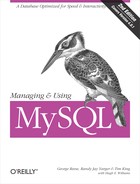Handling MySQL Errors
The script in Example 11-2 includes MySQL error handling. Errors can occur in many different cases. For example, the MySQL DBMS might be unavailable, it might not be possible to establish a connection because the DBMS user’s credentials are incorrect, or an SQL query might be incorrectly formed.
Consider a fragment from Example 11-2:
// Run the query if (!($result = @ mysql_query ($query, $connection))) showerror( );
If the mysql_query( )
function returns false, the function
showerror(
)
is
called to output details of the error:
// Show an error and stop the script
function showerror( )
{
if (mysql_error( ))
die("Error " . mysql_errno() . " : " . mysql_error( ));
else
die("Could not connect to the DBMS");
}If a MySQL error has occurred, the script outputs the error number
and a descriptive string, and the PHP engine stops. If the error
isn’t a MySQL error, there is a problem connecting
to the DBMS with mysql_pconnect( ). The
showerror( ) function is part of the
db.inc include file.
When a function such as showerror( ) is used,
MySQL function calls are usually prefixed with the
@ operator.
The @ stops the PHP engine from outputting its own
internal error messages. If the @ is omitted, the
output of showerror( ) is shown interleaved with
the PHP engine’s internal error messages, which can
be confusing to debug.
